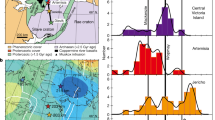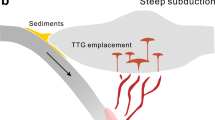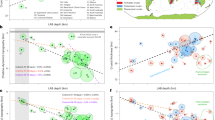Abstract
Cratons record the early history of continental lithosphere formation, yet how they became the most enduring part of the lithosphere on Earth remains unknown1. Here we propose a mechanism for the formation of large volumes of melt-depleted cratonic lithospheric mantle (CLM) and its evolution to stable cratons. Numerical models show large decompression melting of a hot, early Earth mantle beneath a stretching lithosphere, where melt extraction leaves large volumes of depleted mantle at depth. The dehydrated, stiffer mantle resists further deformation, forcing strain migration and cooling, thereby assimilating depleted mantle into the lithosphere. The negative feedback between strain localization and stiffening sustains long-term diffused extension and emplacement of large amounts of depleted CLM. The formation of CLM at low pressure and its deeper re-equilibration reproduces the evolution of Archaean lithosphere constrained by depth–temperature conditions1,2, whereas large degrees of depletion3,4 and melt volumes5 in Archaean cratons are best matched by models with lower lithospheric strength. Under these conditions, which are otherwise viable for plate tectonics6,7, thermochemical differentiation effectively prevents yielding and formation of margins: rifting and lithosphere subduction are short lived and embedded in the cooling CLM as relict structures, reproducing the recycling and reworking environments that are found in Archaean cratons8,9. Although they undergo major melting and extensive recycling during an early stage lasting approximately 500 million years, the modelled lithospheres progressively differentiate and stabilize, and then recycling and reworking become episodic. Early major melting and recycling events explain the production and loss of primordial Hadean lithosphere and crust10, whereas later stabilization and episodic reworking provides a context for the creation of continental cratons in the Archaean era4,8.
This is a preview of subscription content, access via your institution
Access options
Access Nature and 54 other Nature Portfolio journals
Get Nature+, our best-value online-access subscription
$29.99 / 30 days
cancel any time
Subscribe to this journal
Receive 51 print issues and online access
$199.00 per year
only $3.90 per issue
Buy this article
- Purchase on Springer Link
- Instant access to full article PDF
Prices may be subject to local taxes which are calculated during checkout





Similar content being viewed by others
Data availability
All data are generated using Underworld2 version 2.8.1b, available at https://doi.org/10.5281/zenodo.3384283. Data generated are included at https://doi.org/10.26180/5e40f7dcdbe58, licensed under a CC BY 4.0 license. Data in Fig. 2 are from refs. 1,2.
References
Lee, C.-T. A., Luffi, P. & Chin, E. J. Building and destroying continental mantle. Annu. Rev. Earth Planet. Sci. 39, 59–90 (2011).
Artemieva, I. M. The continental lithosphere: reconciling thermal, seismic, and petrologic data. Lithos 109, 23–46 (2009).
Herzberg, C., Condie, K. & Korenaga, J. Thermal history of the Earth and its petrological expression. Earth Planet. Sci. Lett. 292, 79–88 (2010).
Pearson, D. G. & Wittig, N. The formation and evolution of cratonic mantle lithosphere – evidence from mantle xenoliths. In Treatise on Geochemistry Vol. 3 (eds Turekian, K. K. & Holland, H. D.) 255–292 (Elsevier, 2014).
Griffin, W. L. et al. The origin and evolution of Archean lithospheric mantle. Precambr. Res. 127, 19–41 (2003).
Korenaga, J. Initiation and evolution of plate tectonics on Earth: theories and observations. Annu. Rev. Earth Planet. Sci. 41, 117–151 (2013).
O’Neill, C., Lenardic, A., Moresi, L. N., Torsvik, T. H. & Lee, C.-T. A. Episodic Precambrian subduction. Earth Planet. Sci. Lett. 262, 552–562 (2007).
Van Kranendonk, M. J., Smithies, R. H., Hickman, A. H. & Champion, D. C. Secular tectonic evolution of Archean continental crust: interplay between horizontal and vertical processes in the formation of the Pilbara Craton, Australia. Terra Nova 19, 1–38 (2007).
van Hunen, J. & Moyen, J. F. Archean subduction: fact or fiction? Annu. Rev. Earth Planet. Sci. 40, 195–219 (2012).
O’Neil, J. & Carlson, R. W. Building Archean cratons from Hadean mafic crust. Science 355, 1199–1202 (2017).
Jordan, T. H. Structure and formation of the continental tectosphere. J. Petrol. 1, 11–37 (1988).
Kemp, A. I. S. et al. Hadean crustal evolution revisited: new constraints from Pb–Hf isotope systematics of the Jack Hills zircons. Earth Planet. Sci. Lett. 296, 45–56 (2010).
Dhuime, B., Hawkesworth, C. J., Cawood, P. A. & Storey, C. D. A change in the geodynamics of continental growth 3 billion years ago. Science 335, 1334–1336 (2012).
Wang, H., van Hunen, J., Pearson, D. G. & Allen, M. B. Craton stability and longevity: the roles of composition-dependent rheology and buoyancy. Earth Planet. Sci. Lett. 391, 224–233 (2014).
Simon, N. S. C., Carlson, R. W., Pearson, D. G. & Davis, G. R. The origin and evolution of the Kaapvaal cratonic lithospheric mantle. J. Petrol. 48, 589–625 (2007).
Fischer, R. & Gerya, T. V. Early Earth plume-lid tectonics: a high-resolution 3D numerical modelling approach. J. Geodyn. 100, 198–214 (2016).
van Thienen, P., Van den Berg, A. P. & Vlaar, N. J. Production and recycling of oceanic crust in the early Earth. Tectonophysics 386, 41–65 (2004).
Korenaga, J. Archean geodynamics and the thermal evolution of Earth. In Archean Geodynamics and Environments (eds Benn, K. et al.) 7–32 (American Geophysical Union, 2006).
Johnson, T. E., Brown, M., Kaus, B. J. P. & VanTongeren, J. A. Delamination and recycling of Archaean crust caused by gravitational instabilities. Nat. Geosci. 7, 47–52 (2014).
Lenardic, A. & Moresi, L. N. Some thoughts on the stability of cratonic lithosphere: effects of buoyancy and viscosity. J. Geophys. Res. 104, 12747–12758 (1999).
Cooper, C. M. & Miller, M. S. Craton formation: internal structure inherited from closing of the early oceans. Lithosphere 6, 35–42 (2014).
Wang, H., van Hunen, J. & Pearson, D. G. Making Archean cratonic roots by lateral compression: a two-stage thickening and stabilization model. Tectonophysics 746, 562–571 (2018).
Moore, W. B. & Webb, A. G. Heat-pipe Earth. Nature 501, 501–505 (2013).
Rozel, A. B., Golabek, G. J., Jain, C., Tackley, P. J. & Gerya, T. V. Continental crust formation on early Earth controlled by intrusive magmatism. Nature 545, 332–335 (2017).
Sizova, E., Gerya, T. V., Stüwe, K. & Brown, M. Generation of felsic crust in the Archean: a geodynamic modeling perspective. Precambr. Res. 271, 198–224 (2015).
England, P. Constraints on the extension of continental lithosphere. J. Geophys. Res. 88, 1145–1152 (1983).
van Wijk, J. W. & Cloetingh, S. Basin migration caused by slow lithospheric extension. Earth Planet. Sci. Lett. 198, 275–288 (2002).
Arndt, N. T., Lewin, E. & Albarède, F. Strange partners: formation and survival of continental crust and lithospheric mantle. In The Early Earth: Physical, Chemical and Biological Development (eds Fowler, C. M. R. et al.) 91–103 (The Geological Society of London, 2002).
Lee, C.-T. A. & Chin, E. J. Calculating melting temperatures and pressures of peridotite protoliths: implications for the origin of cratonic mantle. Earth Planet. Sci. Lett. 403, 273–286 (2014).
Kopylova, M. G. & Russell, J. K. Chemical stratification of cratonic lithosphere: constraints from the northern Slave Craton, Canada. Earth Planet. Sci. Lett. 181, 71–87 (2000).
Moresi, L. et al. Computational approaches to studying non-linear dynamics of the crust and mantle. Phys. Earth Planet. Inter. 163, 69–82 (2007).
Turcotte, D. L. & Schubert, G. Geodynamics, Application of Continuum Mechanics to Geological Problems (John Wiley & Sons, 1982).
Schutt, D. L. & Lesher, C. E. Effects of melt depletion on the density and seismic velocity of garnet and spinel lherzolite. J. Geophys. Res. Solid Earth 111, B05401 (2006).
Ballmer, M. D., van Hunen, J., Ito, G., Tackley, P. J. & Bianco, T. Non-hotspot volcano chains originating from small-scale sublithospheric convection. Geophys. Res. Lett. 34, (2007).
Ballmer, M. D., Ito, G., van Hunen, J. & Tackley, P. J. Spatial and temporal variability in Hawaiian hotspot volcanism induced by small-scale convection. Nat. Geosci. 4, 457–460 (2011).
Mei, S. & Kohlstedt, D. L. Influence of water on plastic deformation of olivine aggregates. J. Geophys. Res. 105, 21457–21469 (2000).
Hirth, G. & Kohlstedt, D. L. Water in the oceanic upper mantle: implications for rheology, melt extraction and the evolution of the lithosphere. Earth Planet. Sci. Lett. 144, 93–108 (1996).
McKenzie, D. & Bickle, M. J. The volume and composition of melt generated by extension of the lithosphere. J. Petrol. 29, 625–679 (1988).
Crameri, F. & Tackley, P. J. Parameters controlling dynamically self-consistent plate tectonics and single-sided subduction in global models of mantle convection. J. Geophys. Res. Solid Earth 120, 3680–3706 (2015).
Rozel, A., Golabek, G. J., Näf, R. & Tackley, P. J. Formation of ridges in a stable lithosphere in mantle convection models with a viscoplastic rheology. Geophys. Res. Lett. 42, 4770–4777 (2015).
Rolf, T., Capitanio, F. A. & Tackley, P. J. Constraints on mantle viscosity structure from continental drift histories in spherical mantle convection models. Tectonophysics 746, 339–351 (2018).
Karato, S. I. & Wu, P. Rheology of the upper mantle – a sythesis. Science 260, 771–778 (1993).
Keller, T., May, D. A. & Kaus, B. J. P. Numerical modelling of magma dynamics coupled to tectonic deformation of lithosphere and crust. Geophys. J. Int. 195, 1406–1442 (2013).
Dannberg, J. & Heister, T. Compressible magma/mantle dynamics: 3-D, adaptive simulations in ASPECT. Geophys. J. Int. 207, 1343–1366 (2016).
Kohlstedt, D. L. & Hansen, L. N. Constitutive equations, rheological behavior, and viscosity of rocks. In Treatise on Geophysics Vol. 2 (ed. Schubert, G.) 441–472 (2015).
Pinkerton, H. & Stevenson, R. J. Methods of determining the rheological properties of magmas at subliquidus temperatures. J. Volcanol. Geotherm. Res. 53, 47–66 (1992).
Karato, S. I. Deformation of Earth Materials: An Introduction to the Rheology of Solid Earth (Cambridge Univ. Press, 2008).
Phipps Morgan, J. The generation of a compositional lithosphere by mid-ocean ridge melting and its effect on subsequent off-axis hotspot upwelling and melting. Earth Planet. Sci. Lett. 146, 213–232 (1997).
Ito, G., Shen, Y., Hirth, G. & Wolfe, C. J. Mantle flow, melting, and dehydration of the Iceland mantle plume. Earth Planet. Sci. Lett. 165, 81–96 (1999).
Gerya, T. V. Introduction to Numerical Geodynamical Modelling (Cambridge Univ. Press, 2009).
Moresi, L. & Solomatov, V. S. Mantle convection with a brittle lithosphere: thoughts on the global tectonic styles of the Earth and Venus. Geophys. J. Int. 133, 669–682 (1998).
Rey, P. F., Coltice, N. & Flament, N. Spreading continents kick-started plate tectonics. Nature 513, 405–408 (2014).
Capitanio, F. A., Nebel, O., Cawood, P. A., Weinberg, R. F. & Chowdhury, P. Reconciling thermal regimes and tectonics of the early Earth. Geology 47, 923–927 (2019).
Capitanio, F. A., Nebel, O., Cawood, P. A., Weinberg, R. F. & Clos, F. Lithosphere differentiation in the early Earth controls Archean tectonics. Earth Planet. Sci. Lett. 525, 115755 (2019).
Davies, G. F. Effect of plate bending on the Urey ratio and the thermal evolution of the mantle. Earth Planet. Sci. Lett. 287, 513–518 (2009).
Jain, C., Rozel, A. B., Tackley, P. J., Sanan, P. & Gerya, T. V. Growing primordial continental crust self-consistently in global mantle convection models. Gondwana Res. 73, 96–122 (2019).
van Thienen, P., Vlaar, N. J. & van den Berg, A. P. Plate tectonics on the terrestrial planets. Phys. Earth Planet. Inter. 142, 61–74 (2004).
Parsons, B. E. & McKenzie, D. Mantle convection and thermal structure of plates. J. Geophys. Res. 83, 4485–4496 (1978).
O’Farrell, K. A. & Lowman, J. P. Emulating the thermal structure of spherical shell convection in plane-layer geometry mantle convection models. Phys. Earth Planet. Inter. 182, 73–84 (2010).
Katz, R. F., Spiegelman, M. & Langmuir, C. H. A new parameterization of hydrous mantle melting. Geochem. Geophys. Geosyst. 4, 1073 (2003).
Acknowledgements
We thank T. Gerya, C. Herzberg and G. Pearson for comments on the manuscript. We acknowledge support from Australian Research Council grants FT170100254 (to F.A.C.) and FL160100168 (to P.A.C.). We acknowledge the provision of resources and services from the National Computational Infrastructure (NCI), which is supported by the Australian Government.
Author information
Authors and Affiliations
Contributions
F.A.C. and O.N. designed the models. F.A.C. implemented and ran the numerical simulations. All authors contributed to the manuscript.
Corresponding author
Ethics declarations
Competing interests
The authors declare no competing interests.
Additional information
Peer review information Nature thanks Taras Gerya, Claude Herzberg and D. Graham Pearson for their contribution to the peer review of this work.
Publisher’s note Springer Nature remains neutral with regard to jurisdictional claims in published maps and institutional affiliations.
Extended data figures and tables
Extended Data Fig. 1 Mantle adiabats for different potential temperatures, depletion degrees and density difference, for different water-content values versus depth.
Left, potential temperatures for the early Earth are estimated between 1,430 °C and 1,560 °C (blue and green) with respect to the present day (magenta). Right, depletion fraction and potential-density change ΔρP, that is, the differential density due to the difference with potential temperature, for dry solidus (Tsol, solid lines), wet solidus with minimum (dashed lines) and average (dotted lines) estimates of water content37 \({X}_{{{\rm{H}}}_{2}{\rm{O}}}\), and water-saturated solidus Tsat. The yellow area brackets the depletion values inferred for the Archaean3.
Extended Data Fig. 2 Mantle adiabats for present-day mantle potential temperatures at a mid-oceanic ridge and viscosity for different water contents, versus depth.
Left, potential temperatures for the present day and solidi for dry, wet, with different water-content values, and water-saturated mantle, from ref. 37. Right, viscosities of wet (dashed lines), dry (solid thick line) and wet-to-dry transition (thin black line). In grey, the effective viscosity used in this study. Viscosities are calculated using a background strain rate \(\dot{\varepsilon }={10}^{-15}\,{{\rm{s}}}^{-1}\).
Extended Data Fig. 3 Mantle adiabats for mantle potential temperatures ranging from that of the present-day to that inferred for early Earth at a mid-oceanic ridge, depletion degrees and potential-density difference, for dry and wet mantle, and viscosities, versus depth.
Left, potential temperatures for the early Earth are estimated between 1,430 °C and 1,560 °C (magenta and green) with respect to present day (cyan). Solidi for dry and wet, with average water content from ref. 37. Center, depletion fraction and potential density contrast for dry (solid lines) and wet (dashed lines) adiabats. The shaded area brackets the depletion values inferred for the Archaean3. Right panel, corresponding effective viscosities used in this study, calculated using a background strain rate \(\dot{\varepsilon }={10}^{-15}\,{{\rm{s}}}^{-1}\).
Extended Data Fig. 4 Lithospheric geotherms for different thicknesses, depletion fraction, density contrast, and rheology, for an early-Earth-like mantle potential temperature.
Left, the geotherms (half-space cooling) reproduce the effect of thinning of a thick (magenta) lithosphere into a thinner one (blue and indigo). Thin lines for the dry and water-saturated solidi. Centre, the depletion degree and volumes increase with thinning during rifting, and become increasingly shallow. Right, the viscosity of the lithosphere during rifting increases with thinning, as larger melting is produced and embedded in the mechanical boundary layer. Thin line are viscosities for η0, 10η0, 102η0 and 103η0 for the temperature-dependent viscosity η(T) and temperature- and depletion-dependent viscosity η(T, F). Plastic viscosities are ηY for the lithospheric yielding and \({\eta }_{{\rm{Y}}}^{{\rm{C}}}\) for the crust. The viscosity is calculated using σ0 = 50 MPa for the lithosphere and background strain rate \(\dot{\varepsilon }={10}^{-15}\,{{\rm{s}}}^{-1}\).
Extended Data Fig. 5 The strength ratio of the thermochemical boundary layer, with depletion-dependent rheology and the thermal boundary layer versus the thickness of the lithosphere.
Potential temperatures tested are present-day, TP = 1,300 °C, and early-Earth-like, TP = 1,560 °C.
Extended Data Fig. 6 Initial adiabatic temperature distribution.
a, Model configuration after 500 Myr of convection with Ra = 107. The crust is shown in magenta. b, Horizontally averaged temperature. The crust (magenta) is defined by the isotherm T = 330 °C (vertical line; see Methods section ‘Initial conditions’) chosen to yield a mean crust thickness of 20 km. The dashed line represents the lower boundary of the magnification given in c.. c, All model geotherms in grey and the mean geotherm in black; magnification of region in b bounded by the horizontal dashed line and the solid vertical line. The crustal thickness in the initial condition varies between approximately 14 and 35 km.
Extended Data Fig. 7 Melt production and melt rate versus time.
The solid lines are the models presented herein and the dashed lines indicate the models with higher (short-dashed line) and lower (long-dashed line) viscosity cut-offs for three models with low, intermediate and high cohesion (grey, magenta and blue, respectively).
Rights and permissions
About this article
Cite this article
Capitanio, F.A., Nebel, O. & Cawood, P.A. Thermochemical lithosphere differentiation and the origin of cratonic mantle. Nature 588, 89–94 (2020). https://doi.org/10.1038/s41586-020-2976-3
Received:
Accepted:
Published:
Issue Date:
DOI: https://doi.org/10.1038/s41586-020-2976-3
This article is cited by
-
Rift-induced disruption of cratonic keels drives kimberlite volcanism
Nature (2023)
-
Plate Tectonics: The Stabilizer of Earth’s Habitability
Journal of Earth Science (2023)
-
The Habitability of Venus
Space Science Reviews (2023)
-
Thermochemical structure and evolution of cratonic lithosphere in central and southern Africa
Nature Geoscience (2022)
-
Crustal rejuvenation stabilised Earth’s first cratons
Nature Communications (2021)
Comments
By submitting a comment you agree to abide by our Terms and Community Guidelines. If you find something abusive or that does not comply with our terms or guidelines please flag it as inappropriate.



